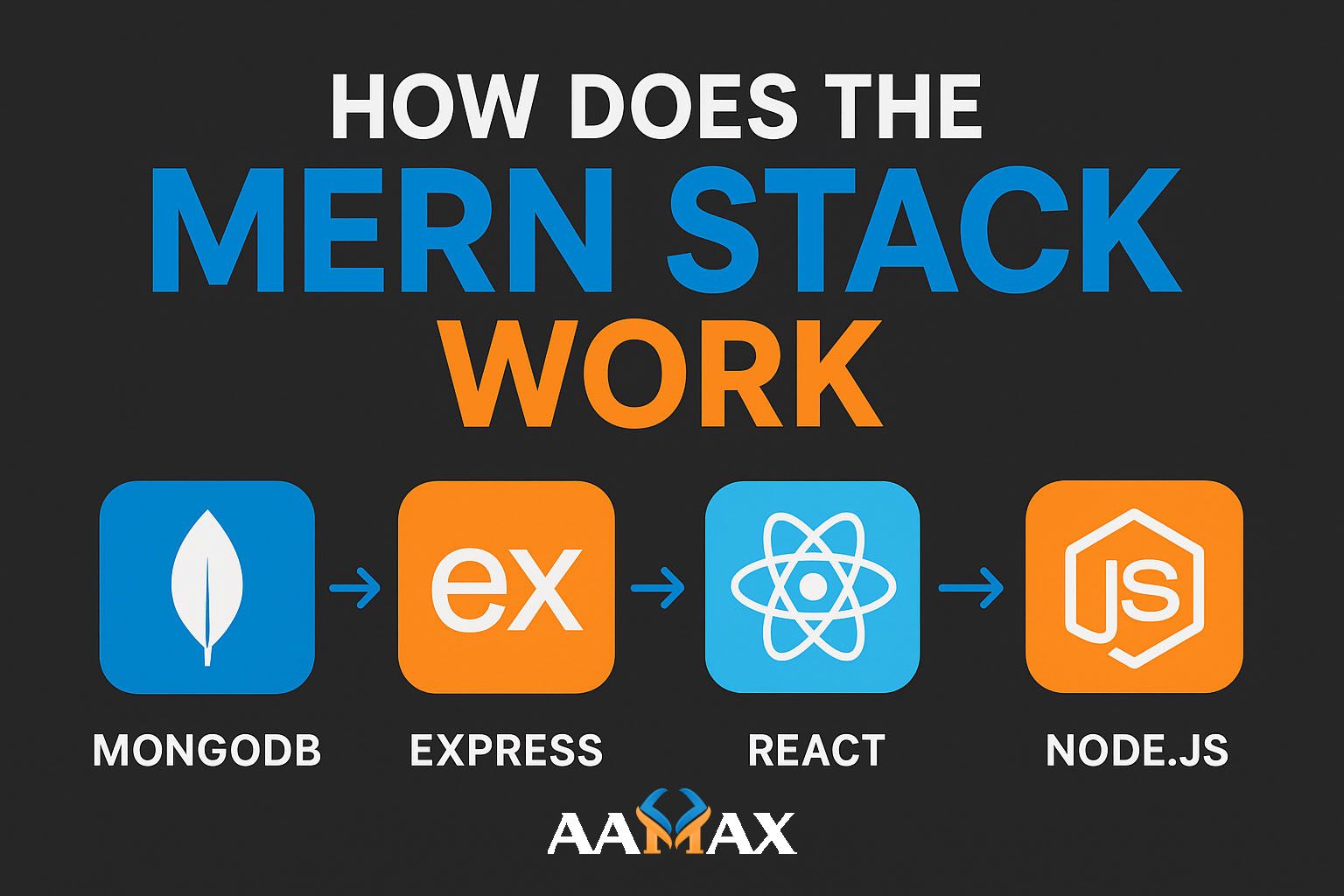
How Does the MERN Stack Work
In the fast-paced digital landscape, businesses need dynamic, scalable, and high-performing web applications to stay ahead of the curve. The MERN stack — which stands for MongoDB, Express.js, React.js, and Node.js — has become a go-to solution for developers and organizations seeking full-stack development efficiency. It’s an end-to-end JavaScript-based framework that allows seamless interaction between front-end and back-end components, creating powerful web applications.
In this in-depth guide, we’ll explore how the MERN stack works, its architecture, key components, advantages, and why businesses worldwide are embracing it. And if you’re looking to build robust, data-driven web applications.
What Is the MERN Stack?
The MERN stack is a collection of four powerful technologies that work together to build full-stack web applications:
- MongoDB – The database layer (NoSQL database)
- Express.js – The server-side framework
- React.js – The client-side (front-end) library
- Node.js – The runtime environment that executes JavaScript on the server
Each layer in the MERN stack plays a crucial role, and together they create a fully functional web application where JavaScript is the single programming language used throughout.
Let’s break down each component to understand its role in the stack.
The Core Components of the MERN Stack
1. MongoDB: The NoSQL Database
At the foundation of the MERN stack lies MongoDB, a NoSQL database that stores data in flexible, JSON-like documents instead of traditional rows and columns. This makes MongoDB highly adaptable to modern applications that require dynamic data storage.
Key features of MongoDB include:
- Schema-less structure, allowing flexibility in data models
- High scalability with horizontal partitioning (sharding)
- Built-in replication for data redundancy
- JSON (BSON) document storage that integrates naturally with JavaScript
MongoDB communicates with the Node.js backend through the Mongoose library, which acts as an Object Data Modeling (ODM) tool. This integration ensures smooth data handling and simplifies CRUD (Create, Read, Update, Delete) operations.
2. Express.js: The Backend Framework
Express.js serves as the backend web framework that runs on Node.js. It simplifies server-side logic by providing a lightweight, minimal, and flexible set of tools to build RESTful APIs.
How Express.js fits in:
- Acts as a bridge between the front-end and the database
- Handles HTTP requests and routes them to the appropriate logic
- Manages middleware to handle authentication, cookies, sessions, and more
- Supports MVC architecture for organized development
In essence, Express.js provides the backbone for how the application processes user requests, communicates with the database, and sends responses back to the client.
3. React.js: The Front-End Library
React.js, developed by Facebook, powers the front-end of the MERN stack. It’s a component-based JavaScript library used for building dynamic and interactive user interfaces.
Key benefits of React include:
- Virtual DOM for faster rendering
- Reusable components for cleaner code
- One-way data flow for predictable application behavior
- Excellent performance for Single Page Applications (SPAs)
When paired with Express and Node.js, React handles all the client-side rendering, allowing users to interact with the app without needing full-page reloads. This creates a smooth, app-like experience that’s essential in modern web design.
4. Node.js: The JavaScript Runtime
At the base of the MERN stack, Node.js serves as the server-side runtime environment. Built on Google’s V8 engine, Node.js allows developers to run JavaScript on the server, enabling full-stack JavaScript development.
Advantages of Node.js:
- Non-blocking I/O and event-driven architecture for high performance
- Cross-platform compatibility
- Rich package ecosystem (npm)
- Efficient handling of multiple client requests
Node.js empowers developers to use the same language — JavaScript — across both client and server, making the development cycle more streamlined and efficient.
How the MERN Stack Works Together
To understand how the MERN stack works, let’s look at the workflow of a typical MERN-based web application:
-
User Interaction (React Front-End)
The user interacts with the web application interface built using React. Actions such as form submissions, button clicks, or navigation trigger events handled by React components. -
HTTP Request to Express Server
When a user performs an action requiring data from the server (e.g., fetching user details), React sends an HTTP request (using Axios or Fetch API) to the Express.js server. -
Backend Logic (Express + Node)
Express receives the request, processes it using middleware, and applies any necessary business logic. It then communicates with the MongoDB database to retrieve, store, or modify data. -
Database Operations (MongoDB)
MongoDB performs the requested operation and sends the response (usually in JSON format) back to the Express server. -
Response to Client
Express.js sends the response back to the React front-end. React dynamically updates the user interface without reloading the page.
This entire workflow ensures fast, smooth, and efficient data exchange, forming the backbone of a Single Page Application (SPA) experience.
The Architecture of the MERN Stack
The MERN stack follows a three-tier architecture:
1. Presentation Tier (Front-End)
The React.js layer manages everything users see and interact with. It’s responsible for rendering the UI and making asynchronous API calls to the backend.
2. Application Tier (Back-End)
This is the Express.js and Node.js layer that processes the client requests, applies business logic, and serves as the link between the front-end and database.
3. Data Tier (Database)
MongoDB forms the data layer where information is stored and retrieved. The Mongoose ODM simplifies this interaction by providing schema-based models and validation.
This three-tier architecture ensures modularity, scalability, and clear separation of concerns.
Advantages of the MERN Stack
1. Full-Stack JavaScript
One of the biggest advantages of MERN is that it uses JavaScript across all layers. This eliminates the need to switch languages between the front-end and back-end, resulting in faster development cycles and easier maintenance.
2. Open Source and Cost-Effective
All MERN technologies — MongoDB, Express, React, and Node — are open-source, which makes them budget-friendly for startups and enterprises alike.
3. High Performance and Scalability
Node.js and React are designed for speed and performance, while MongoDB handles scalability effortlessly, making MERN ideal for large-scale applications.
4. Rapid Development
Reusable React components and ready-to-use Node.js modules allow developers to build applications faster and with fewer resources.
5. Excellent Community Support
Each technology in the MERN stack has a large, active community, ensuring ongoing updates, plugins, and tools that simplify complex tasks.
Use Cases: When to Use the MERN Stack
The MERN stack is ideal for:
- Single Page Applications (SPAs) – Dynamic web apps that load data without page reloads
- Real-Time Applications – Such as chat apps, live dashboards, and collaboration tools
- E-commerce Platforms – With complex product data and user interaction
- Social Media Applications – Interactive platforms with continuous updates
- Content Management Systems (CMS) – Flexible backend systems for content publishing
MERN’s flexibility and scalability make it suitable for nearly any modern web project that requires speed and interactivity.
Challenges and Considerations
While the MERN stack is powerful, it also has a few challenges to keep in mind:
- Learning Curve: Developers need to master four separate technologies and understand how they interact.
- SEO Limitations: Since React is client-rendered, optimizing for SEO can be challenging unless server-side rendering (SSR) or Next.js is implemented.
- Performance Overhead: For very large applications, managing multiple layers can become complex.
However, with the right expertise, these challenges can be mitigated effectively — something professional development teams like AAMAX excel at handling.
Why Hire AAMAX for MERN Stack Development
Building a modern web application requires technical expertise, strategy, and creativity. That’s where AAMAX stands out. As a full-service digital marketing company, AAMAX not only provides exceptional MERN Stack Development, but also offers Digital Marketing and SEO services to ensure your web application performs optimally across all fronts.
AAMAX’s MERN stack services include:
- Full-stack web application development
- Custom API and backend integration
- Scalable MongoDB database design
- Responsive front-end interfaces using React
- Application performance optimization
- Ongoing support and maintenance
Whether you’re a startup looking to launch your MVP or an enterprise aiming to scale, hiring AAMAX means partnering with professionals who understand both the technical and strategic side of digital success.
Conclusion: The Future of Web Development with MERN
The MERN stack isn’t just another tech trend — it’s a robust, future-proof framework powering countless modern web applications. By combining the speed of JavaScript, the efficiency of Node.js, the flexibility of MongoDB, and the interactivity of React, it offers a complete ecosystem for building high-performing web solutions.
As businesses continue to demand faster, more dynamic, and user-centric applications, the MERN stack will remain a cornerstone of full-stack development. And with expert partners like AAMAX, you can leverage its full potential to build digital experiences that drive growth and engagement.
Ready to build a powerful, modern web application?
Hire AAMAX for professional MERN Stack Development Services, and take your digital presence to the next level.







